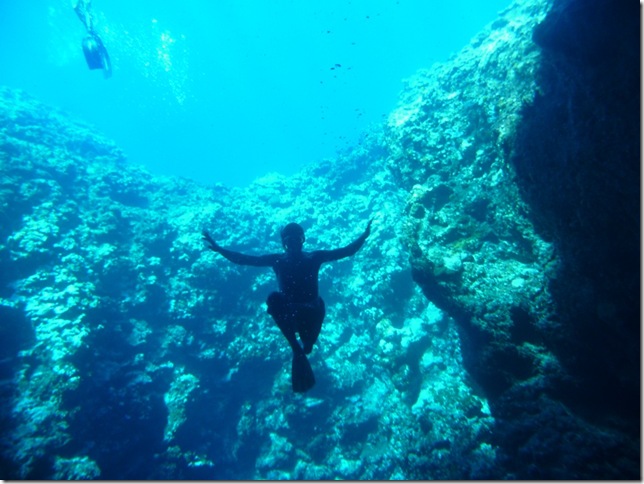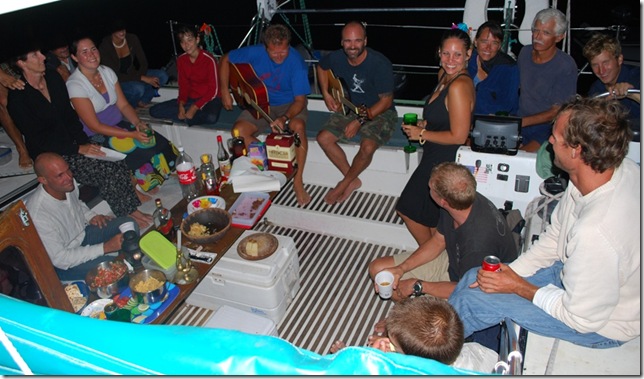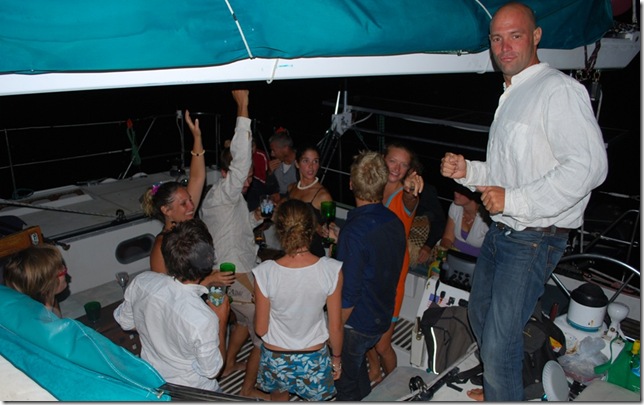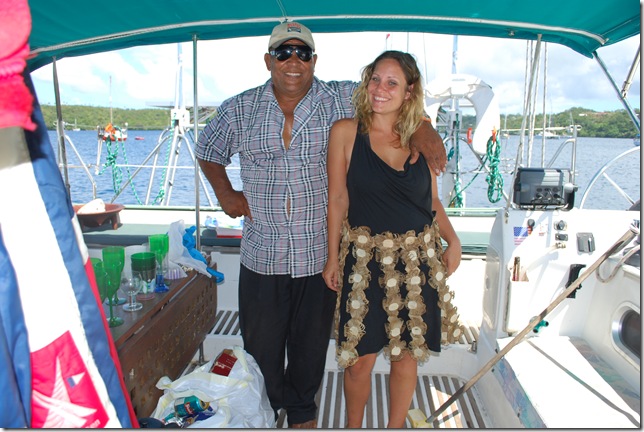Neiafu harbor is one of the congregating places for cruising boats in the South Pacific (Marina Taina in Tahiti and Bora Bora are the other two we’ve seen). With all the boats moored and anchored in the harbor as well as the nearby anchorages, channel 16 is constantly crackling with boats hailing each other. All of the waterfront businesses standby on 16 as well. Old friends meet up again and new friends are made. You can map out the social networks just by listening to channel 16 — “Paje, Paje, this is Beduina”; Matajusi, Matajusi, Paje”; “Avel Mad, Avel Mad, Migration”; “Anima, Anima, Pura Vida”; and so on from the early morning until late at night. Good friends, good restaurants, friendly locals, free internet, good weather, safe and comfortable moorings, and reasonable prices, combine to make the days disappear.
Tonga itself is an interesting country. It’s a monarchy, and the king is no figurehead. Even though there is a prime minister, cabinet, and elected legislature, he has absolute power. Tongans are proud of being the only country in the Pacific that was never colonized and essentially remained independent from the time of the first European explorers to the present. After several ill-fated attempts, missionaries finally met with success in Tonga and converted the royal family. Tonga was just starting to establish is western-style government at the time, and things change slowly here, so the influence of the 19th century missionaries is still pretty apparent in this traditional, hierarchical society. On Sundays, radio stations may only play religious music, fishing and swimming are banned, and most businesses are closed. On any day of the week, there is a fine if men appear in public without a shirt, and nearly all Tongans swim fully clothed (shorts and shirt). It’s a bit unusual for Westerners, and especially cruisers. With nice weather most of the time and no one around for miles the two main reasons for wearing clothes are gone. Add to that doing laundry by hand, and many cruisers we’ve met return from passages or isolated anchorages with very little dirty laundry.
Sunday afternoon, we joined a group of about 11 cruisers aboard Anima III to visit Mariner’s Cave. The cave is on the steep north shore of Nuapapu and is entered from the sea by free diving down to about 8 feet then swimming 15 feet or so into the cave, where you can surface. We all went together for fun, and because the water is too deep to anchor, so someone has to stay aboard a drifting boat while others go into the cave. There’s a 3-page story in the cruising guide by a woman who lived in Vava’u 26 years before getting up the courage to go in, complete with the story of a copra ship officer who was killed when he surfaced too early and opened up his head on the rocks, but I think it’s just there to give you a bigger sense of accomplishment once you’ve done it. As they say, if you can dive a couple of yards away from the side of a sailboat, swim under the keel, and surface a couple of yards away on the other side, you’ll have no problem entering the cave. The difference is that you know how wide the boat is and that there’s open water on the other side. Your air seems to go pretty quickly when you’re swimming in as fast as you can and constantly searching for the point where the surface is no longer rock, but everybody made it with no problems. It was an overcast day, and after Bubble Cave in Niue, the interior didn’t seem incredibly impressive, but it was a nice cavern with a large entrance. After we had been in for a little bit, something really cool happened. As we were treading water, a swell came in, raising the water level in the cave. Because the cracks to the outside air above are relatively limited, the air pressure increased as the wave entered. As we cleared our ears to adjust, we were enveloped by a fog. With the air in the cave being saturated with water vapor, the small increase in pressure with an entering wave is enough to cause the vapor to condense and form fog. As the wave ran out and the water level fell, the fog dissipated. This happened several times before we finally dove out of the cave and returned to Anima for the short sail back into Neiafu harbor. Thanks to one of our fellow cruisers for the two pics below.
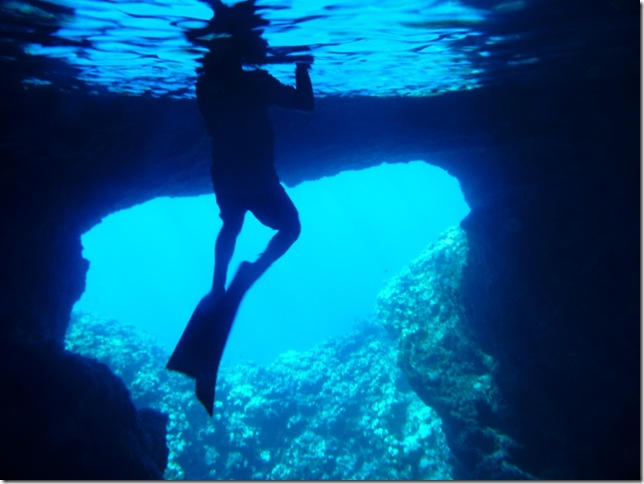 View from inside the cave looking out through the underwater entrance
View from inside the cave looking out through the underwater entrance
Tiffany’s birthday party on Sunday night was a big hit, as Tiff and everyone else seemed to have great time. We ended up with 26 people, and between the large cockpit and adjoining salon, there was enough space for most people to sit and graze on the nice spread of food. After we consumed a little “liquid courage”, it was time to sing. That afternoon we had joined up with Martin and Hans to rewrite the pop song “Breakfast at Tiffany’s” to fit with the theme of “Birthday for Tiffany”, and Lauren recruited a couple of other cruisers at the party to join her in singing the song to Tiff while Martin and Hans accompanied on their guitars. After that, members of the larger group took turns singing the traditional “Happy Birthday” songs in their respective languages (French, German, Swedish, French Canadian, and a Russian dialect). Incidentally, the French and Germans use the same tune that we do, while the others have totally unique songs. We sang a few Beatles songs after that, and 13-year-old Lisa from S/V Anyway impressed us all with her repertoire. She knew all the words, and her father explained that it was important to him to expose her to the classics. Once the crowd thinned out, it was time to dance. We had had a great time putting together a playlist of dance music earlier that morning, and several of the guests our age were familiar with the songs. They must have been enjoying themselves, as several of them stayed until 5 a.m.! We were surprised that all of the food managed to be eaten but then realized that it was a 10 hour party!
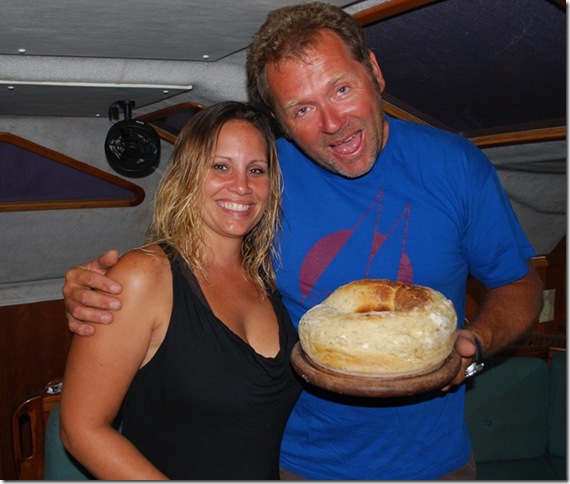 The birthday girl and Martin with his garlic bread
The birthday girl and Martin with his garlic bread
As you can imagine, Monday was a slow day, although we did manage to wake up at 8:30, when our overnight guests roused themselves to make the dinghy ride back to their boat. Not too long afterward, a local man rowing a small boat approached our stern and prepared to board. I said hello, then Tiffany went over to talk to him and help him tie up. I assumed they’d met ashore, but they hadn’t. He was looking for a cup of coffee, and we had some almost ready, so he soon had a cup. I asked what we could do for him, and is halting English he responded, “Mickey, I come from Pangiamotu,” and pointed to the large island at the south end of the harbor. OK, that didn’t help much, but he was friendly. It turns out he was selling handicrafts his wife had made. We were out of Tongan money, but he accepted New Zealand and US dollars, so we ended up with a bracelet and a Tongan courtesy flag.
After lunch with Martin at the Yacht Club (my first real omelet since Key West), some errands and a short nap, we managed to make it over to Disa for a going-away dinner for Anders, who’s returning to Sweden today. Anders had spent a year in Spain and treated us to a boat-style tapas dinner. Nick, a young single-hander (www.bigoceans.com), joined us and somehow we kept our eyes open swapping stories and laughing until 2am. Nick is one of several people we’ve met here who experienced the tsunami while in Samoa or Tonga, and their stories are really amazing.
After five days, we finally motored out of Neiafu toward anchorage #16 in the bight of Nuapapu. Not only did we want to explore the islands and reefs of Vava’u, we really needed some sleep. The Moorings (sailboat charter company) cruising guide for Vava’u is used by pretty much everybody, and it numbers all of the anchorages for convenience, which makes for odd conversations with everyone talking about going to 11 or 16 or having a nice time at 7, etc. For the record, #16 is very pretty with an incredible reef a short dingy ride away.


